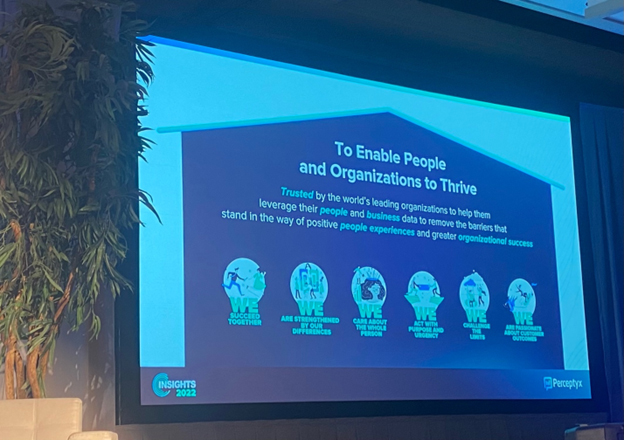Update from the Road: Perceptyx Reports Strong Growth at its Insights Conference
May 18th, 2022
I spent the last two days in Texas with the Perceptyx team and approximately 200 of their customers. Held at the Hyatt Lost Pines resort, about 30 minutes outside of Austin, the event was an enthusiastic celebration of being together again and of Perceptyx’s successes over the last few years. The team also made sure event attendees got a good dose of Texan culture, bringing in longhorn steers, a top-notch country western band (complete with line dancing lessons), and wonderful Tex-Mex food.
While I live-Tweeted the opening keynotes from CEO John Borland, CTO Sham Telang, and their external keynote presenter Seth Mattison, I thought it could be useful for you all if I do a quick round-up of key takeaways from the event. Here are the top highlights:
- Significant growth since pre-pandemic
- Excellent customer stories
- Compelling vision around the product roadmap
Significant growth since pre-pandemic
In the opening session, Borland expressed his thanks to customers both for attending the event (approximately 80-90% indicated via a show of hands that this was their first post-pandemic event) and for their support during the pandemic. He has good reason to be thankful: Since before the pandemic, Perceptyx experienced a 260% growth in revenue and a 150% growth in the number of customers. Further, many of those customers are blue-chip companies, as was shown in their slide of customers in attendance at the event.
It appears that Perceptyx has been able to manage that growth effectively, given that they reported a Net Promoter Score© (NPS) of 74, which is higher than the people analytics tech industry average of 59.
Excellent customer stories
Given that NPS, it is not surprising there were a plethora of strong customer stories on display at the event. Some of the most notable came from the main stage, where the following organizations presented:
- Abbvie, S&P Global, and Advocate Aurora Health had Dr. Bethany Dohleman (Director, Human Capital Research), Kate Brown (VP, Culture and Engagement), Meghan O’Brien (People Project Lead), and Rebecca Daisley, PhD (Director of Talent Management) present on “How to Future-Proof Your Organization.”
Key Insight: Flexibility and agility are key to transformation.
- AB InBev had Valerie DuBois (Global Director, Employee Experience) present on “The Secret to Empowering and Influencing Your Leaders.”
Key insight: By putting data in the hands of managers, you can create ownership of understanding and solving the people problems orgs face.
- UC Health, where Matthew Gosney (VP of Organizational Development) and Ashley Bruning (Chief Nursing Officer) presented “Create an Employee Voice Strategy Built for Impact.”
Key insight: The conversation is the relationship. (Oh, and Colorado is drop-dead beautiful.)
- WPP (the largest advertising agency holding company) had Judy Jackson (Global Head of Culture) talk about “Getting Comfortable (and Brave) with the Uncomfortable.”
Key insight: Meetings are like plays – you need to know your audience and which actor will best deliver which line. Sometimes, if you are part of an under-represented population, the right “actor” to present sensitive race / ethnicity data is someone from the majority population.
All of those sessions will be available on replay later, and I suggest you have a listen to them, if you have the chance.
I also had a chance to attend a few breakout sessions, and especially enjoyed the following ones:
- Ahold Delhaize had Shanna Daugherty (Global Manager Associate Development) present “An ‘Ecosystem’ Listening Model for A Disparate Workforce.”
Key insight: A comprehensive listening strategy will allow you to create meaningful insights, such as measuring the link between employee experience and store performance and the impact of leadership development programs.
- Boeing had Kristin Saboe, PhD (Senior Manager, Employee Listening, Research, and Talent Strategy) and Frank Zemek (Employee Relations Specialist, Employee Engagement Survey) present “Innovative Approaches to Continuous Listening & Acting at Scale.”
Key insight: Enabling employees to launch their own surveys can unleash incredible power in orgs, but needs to still have some centralized management so as to stay legally compliant, make sure audiences aren’t over-surveyed, and stakeholders are appropriately engaged. It also scares the heck out of a lot of practitioners (judging from the questions in the room).
Compelling vision around the product roadmap
In the morning, Sham Telang, CTO, shared the product roadmap. He indicated that Perceptyx is trying to solve the problems of:
- Fragmented data
- Disjointed user experience
- Missing linkage between employee experience, behaviors, and actions
- Manual reporting and analytics
The way Perceptyx is trying to address this is by offering four distinct product and platform capabilities – Monitor, Listen, Enable, and Activate (see Figure 2) – under one umbrella (see Figure 3). The idea is that the four products, Ask, Sense, Dialogue, and Develop, will enable a holistic listening strategy for organizations.
As many of you know, Perceptyx recently acquired three companies, CultureIQ, Waggl, and Cultivate. This new 4-product strategy heavily incorporates those latter two acquisitions, specifically:
- Ask – This is the traditional Perceptyx employee experience and engagement product, which can include big annual census surveys or other special-focus surveys (e.g., DEIB, Covid-19).
- Sense – This is the traditional Perceptyx lifecycle and pulse survey product, but it will have some of Cultivate’s passive listening capabilities integrated into it moving forward.
- Dialogue – This is the Waggl acquisition, which can enable crowdsourcing, conversations, pairing and voting (using conjoint analysis techniques). Perceptyx is positioning this as a way to accelerate action planning after using the Ask or Sense products by immediately engaging the organization in crowd-sourced ideation and discussions about how to move forward (see Figure 4).
- Develop – This is the Cultivate acquisition paired with the traditional Perceptyx 360 offering (see Figure 5). The initial offering will be combining that 360 information with feedback on employees’ behaviors, derived from their digital exhaust, to provide insight into their “blind spots.” For example, if someone indicated in a 360 that their manager doesn’t recognize them enough, but the manager thinks they do recognize enough, then Cultivate can then flag for that manager when they are recognizing their employee less often than usual or less than their colleagues.
I’m not sure where or in what ways CultureIQ is incorporated into this product strategy.
A number of other updates were also mentioned:
- Listening Home – This is designed to be a one-stop-shop for finding all of this listening data and for developing action plans on it (see Figure 6). It will include an “In the flow of work” bot (presumably based on Cultivate) to provide nudges, coaching with recommendations, etc.
- Seamless HCM integration – Today, Perceptyx integrates HCM data via flat files. Beginning in Q3, they will have integrations with all the major players (Workday, SuccessFactors, and Oracle).
- Upgraded UX for Analyze dashboards – This was just released prior to the conference, and actually generated a spontaneous cheer in the room, indicating folks’ enthusiasm. The new UX has a better look and feel, improved underlying infrastructure, and faster performance.
- ML/NLP-powered dashboards – Coming in Q4, Perceptyx plans to improve its ability to use machine learning (ML) and Natural Language Processing (NLP) to highlight sentiment and insights from the data. These will first roll out to their Engagement, D&I, Attrition, and Benchmark surveys.
- Standardized widgets for dashboard creation / configurable dashboards – Billed as “coming soon,” Perceptyx is enabling customers to use standardized widgets to create custom dashboards. They are also offering more out-of-the-box dashboards, which customers can configure. In conversations with customers, this enhancement was one of the ones that excited them most.
Final thoughts
Perceptyx has significant momentum and a clear vision for being a one-stop-shop for employee listening. As one of the (dwindling number of) independent vendors left in the space, they are able to focus on customers’ needs exclusively, without being distracted by the demands of a larger organization that may have other primary objectives. Perceptyx is driven by its vision, mission, and values (see Figure 7), which have a strong emphasis on succeeding “together” with customers. That customer-centricity came through strongly in many of the conversations I had with customers at the event.
The next thing will be for Perceptyx to deliver on their product vision by effectively integrating its acquisitions. While Waggl was the acquisition customers seemed to most intuitively understand – this may be because it’s an older acquisition so Perceptyx could more effectively message how it fits in – I am most excited by the opportunity for Cultivate to help Perceptyx differentiate itself more from its competitors. The underlying AI, which will power sentiment analysis, collaboration analysis, and targeted nudges, has the potential to truly change how employees and leaders understand themselves and their teams. I’m looking forward to seeing what the next year has in store for Perceptyx.






